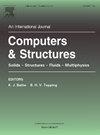On the use of the inverse finite element method to enhance knowledge sharing in population-based structural health monitoring
IF 4.4
2区 工程技术
Q1 COMPUTER SCIENCE, INTERDISCIPLINARY APPLICATIONS
引用次数: 0
Abstract
Efficient Structural Health Monitoring (SHM) is critical for ensuring safety and improving the operation and maintenance of aerospace structures. This study focusses on advanced shape-sensing methods, such as the inverse Finite Element Method (iFEM), which can estimate the complete displacement field of a structure based on a restricted number of strain measurements, fostering continuous and real-time monitoring. This approach additionally provides valuable insights into the dynamic behaviour of a structure by extracting its Frequency Response Functions (FRFs) and modal properties to perform vibration-based SHM. However, effectively extending SHM to a fleet or population of structures would require a significant amount of data for each one, which may be unavailable or incomplete. A population-based Structural Health Monitoring (PBSHM) strategy can solve data scarcity by sharing knowledge between similar structures via transfer-learning algorithms. In PBSHM, handling data from diverse sources is paramount for achieving accurate results. Therefore, this study integrates iFEM into the PBSHM framework, enhancing knowledge transfer by harmonising fibre-optic strain measurements to vibration-based features and providing reliable source data to inform diagnostics on similar structures. The proposed approach is validated on a population of laboratory-scale steel aircraft subjected to specific operating and damage conditions tested using three different sensor setups.
求助全文
约1分钟内获得全文
求助全文
来源期刊

Computers & Structures
工程技术-工程:土木
CiteScore
8.80
自引率
6.40%
发文量
122
审稿时长
33 days
期刊介绍:
Computers & Structures publishes advances in the development and use of computational methods for the solution of problems in engineering and the sciences. The range of appropriate contributions is wide, and includes papers on establishing appropriate mathematical models and their numerical solution in all areas of mechanics. The journal also includes articles that present a substantial review of a field in the topics of the journal.
 求助内容:
求助内容: 应助结果提醒方式:
应助结果提醒方式:


